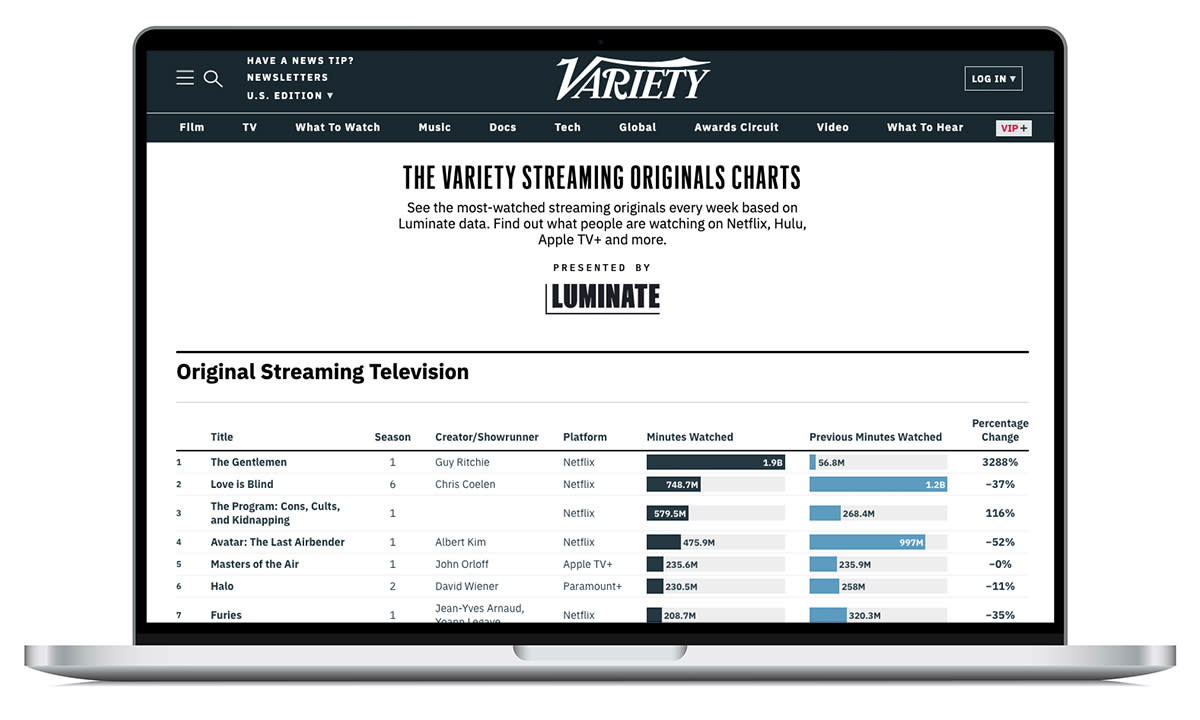TV’s Latest Epic Battle: Upstart Audience Measurement Firms Take Aim at Nielsen’s Ratings Dominance

The day after the Super Bowl typically brings with it another kind of celebration: Nielsen’s annual announcement of the size of the audience for the NFL extravaganza. This year, someone stole some of the spotlight from the measurement giant with an end run.
In the early afternoon hours of Feb. 12, iSpot, one of a handful of audience-measurement upstarts that are vying for business from many of Nielsen’s top clients, issued “preliminary audience measurement estimates” for Super Bowl viewership, projecting the Big Game had lured more than 126.6 million viewers across TV, linear, streaming and out of home watching. Nielsen didn’t issue its estimate — more than 123.4 million viewers across linear and streaming — until well into the evening.
More from Variety
Comscore Wins Media Rating Council Accreditation for Some National, Local TV Measurement
Variety to Launch Streaming Originals Charts Presented by Luminate
The efforts to beat Nielsen to the punch were deliberate, says Stuart Schwartzapfel, iSpot’s senior VP of media partnerships. “We wanted to prove that we could provide accurate and consistent overnights in a rapid fashion, and that’s the time we were able to do it in,” he says.
The skirmish illustrates the heightened tension and stakes for the industry as it grapples with changing audience-measurement protocols. Indeed, the drama on “Yellowstone” and “Game of Thrones” is no match for the battle the entire TV business is waging to control how the medium is measured. Companies such as iSpot and rivals including VideoAmp, Comscore and Luminate (owned by Variety parent company PMC) all want to take at least some of the millions of dollars media companies like Disney, NBCUniversal or Paramount Global pay to Nielsen each year. Meanwhile, Nielsen is poised to roll out new tabulation systems, like Nielsen One, that will count audiences for video as they traverse from linear to streaming and from one type of screen to another one
To go after Nielsen’s core business, these newer providers have promised new kinds of data that help advertisers find smaller consumer niches like people in the market for a new car, likely moviegoers or growing families. In the age of streaming, when more people watch their TV favorites on interactive broadband hubs like Hulu, Netflix or Max, marketers have to work harder to find their likeliest customers, fewer of whom assemble in front of the TV screen at a specified time or date — i.e. Thursdays at 8 p.m. on NBC to watch “Friends.” Having this sort of information helps as linear audiences, the ones they once counted on, continue to splinter and migrate to their own video paths across Hulu, Netflix or Tubi.
Little wonder that more measurement companies are gaining traction. Many executives involved in the sector believe there is room for several of them to thrive. “It is a multi-player race going forward,” says Steve Bagdasarian, chief commercial officer at Comscore. “I don’t see it as a one winner takes all scenario.”
RELATED CONTENT: Variety to Launch Streaming Originals Viewership Charts Presented by Luminate
The companies jockey for position just as the industry plans for its annual “upfront” market, when U.S. TV networks try to sell the bulk of their commercial inventory for their next programming season. For the past two years, companies such as Warner Bros. Discovery, Disney, Paramount, Fox and NBCUniversal have all tested alignments with one or more of the new measurement outlets, hoping to snare new business and put some pressure on Nielsen at the same time.
In 2024, there will be more: Comscore has just gained accreditation for some parts of its services from the Media Rating Council, an industry watchdog that analyzes the quality of audience measurement tools certain aspects of local and national audience measurement services. Previously, only Nielsen’s services had that broad stamp of approval, which remains of critical importance to many large advertisers.
Some non-traditional players have also stepped into the arena. Starting next week, Variety plans to publish new rankers analyzing the most-viewed original streaming film and TV series, using data from Luminate, a data and research business. The Luminate data focuses on original streaming movies tnad TV programs on such subscription-based streaming platforms including AMC+, Amazon Prime, Discovery+, Disney+, Hulu, Max, Netflix, Paramount+ and Peacock.
“We can very easily allow our partners and customers to see something like how horror performs on a particular platform, or a high-school ensemble drama,” says Mark Hoebich, executive VP and head of film and TV for Luminate. One distinction from some data providers, he says, is that Luminate information refreshes daily, while some others take weeks to compile views. That means Luminate can approximate what was once known in the business as “overnights” about how many people viewed content via several streaming platforms. At present, Luminate cannot provide data on the age or gender characteristics of the streaming audience, but hopes to be able to start by the third or fourth quarter of 2024, Hoebich says.
RELATED CONTENT: Nielsen Switches CEOs as Rivals Stir Up Measurement Market
In an era when streaming is disrupting the traditional media business, there are many firms with deep pockets who hope to make at least a few bucks while they upend the practice of counting the viewers who watch TV programs and commercials. Nielsen was purchased in 2022 by a private equity consortium for $16 billion. Goldman Sachs in 2022 took a stake in iSpot valued at $325 million in iSpot. Raine Group, the media investment and advisory firm, was a backer of VideoAmp.
Forging a few new media yardsticks may also help the sector wring new cash flow as well. Measurement is “one of the few levers” that companies like Paramount or Warner Bros. Discovery “can pull to actually increase revenue,” says Peter Liguori, the former FX network chief and Tribune CEO who was recently named chairman of VideoAmp. If media companies can get more precise about who is watching, there is hope advertisers will be more willing to pay higher rates because they will reach more of their most likely customers. “How many more productions can you cut, budgets can you limit, people can you lay off,” asks Liguori, noting that counting viewers in more precise fashion could help generate new dollars.
Advertisers want the data and are open to having new providers supply it, says David Sederbaum, executive VP and head of video investment at large media-buyer Dentsu. There is, he says, “a recognition that clients and agencies need to make informed decisions that are right for their business, as opposed to being told what they have to transact on. We are not at a point where there is one right answer.”

Such sentiments won’t keep the best-known measurement company from trying to maintain its dominance on the ratings that provide the currency for advertising pacts — and the numbers for bragging rights among platforms and Hollywood creatives. Nielsen, the gold standard in audience measurement for decades, is ready to introduce Nielsen One, a new system that will consider usage of media across linear, digital and broadband screens. And the company, whose loss of industry accreditation for nearly a year and a half allowed some of the newer competitors to gain ground, has gained some sway since it reversed its plan to drop the old metrics that the industry still uses, the so- called “C3” and “C7” tabulations that examine the viewership levels of average commercial minutes up to three or seven days after the ads air. Nielsen had previously planned to drop the measures by the fall of 2024.
“Where we mistepped is saying we will take away this other thing” while in the course of bringing new products to market, says Deirdre Thomas, Nielsen’s chief product officer. “We heard our clients, and they are not ready to get rid” of C3 and C7. And while Nielsen has faced challenges in recent years, she adds, it is stepping up its efforts in the battle. “Admittedly, we have been behind, but we are not any more,” she says.
There is a growing sense among the upstarts that Madison Avenue won’t hold them to account to such a degree. Gaining MRC approval is an important step, says VideoAmp’s Liguori. Still, he says. “it’s just an added layer of security some brands want, but it is not critical,” and there are agencies and networks already doing advertising deals based on his company’s data. In June, Allen Media Group unveiled a 10-year deal with VideoAmp that makes it the sole backer of the audience data it uses to strike national ad deals with advertisers for properties such as The Weather Channel. An industry group backed by many of the biggest traditional media companies is expected in weeks to come to unveil new “certifications” of various measurement technologies in a bid to make Madison Avenue feel more at ease with new numbers.
Not everyone is prepared to throw dollars so quickly at the new technologies. MRC accreditation “is definitely important,” says Laurie Crowley, senior VP and group director of Havas Media. “And there is a lot of time and money being spent in seeking” that approval. Indeed, others are working to gain MRC backing. And Nielsen will have to win it again for Nielsen One.
Even as TV networks and measurement start-ups vie for new business, it seems clear that what they count may be in flux. More marketers are placing new emphasis not on delivering mass audience impressions for their commercials, but tangible evidence that the people who saw the ads were spurred to take action, like visiting an auto showroom or buying a movie ticket.
“The ability to provide business impacts as a result of a media investment is going to start taking center stage in upfront narratives,” says iSpot's Schwartzapfel.
Already, A+E Networks has unveiled a new tool that examines search activity and brand recall around ads that run on its media properties. Nielsen has struck up a partnership with EDO, a technology company co-founded by actor Edward Norton that examines data on consumers’ online search activity and website visits, among other actions. Understanding those dynamics, says Nielsen's Thomas, "can help unlock" valuable information about where ads perform best.
When the media and advertising industries tried to change the currency of the industry from basic Nielsen measures to so-called “commercial ratings,” they sparked a process that took at least two years to complete. Now they have one in place that will take significantly longer. Determining the winner will take years and millions of dollars. The struggle to capture the measurement market, says Comscore’s Bagdasarian, "is really more of a marathon."
Best of Variety
From 'The Idea of You' to 'Apples Never Fall': The Best Book-to-Screen Adaptations to Read This Year
Sign up for Variety’s Newsletter. For the latest news, follow us on Facebook, Twitter, and Instagram.
